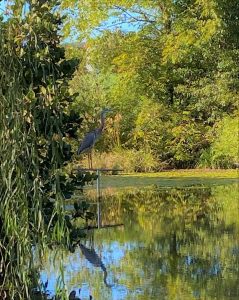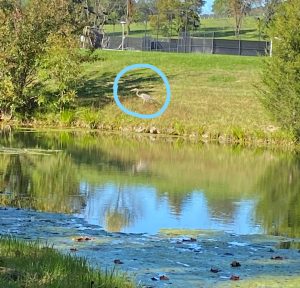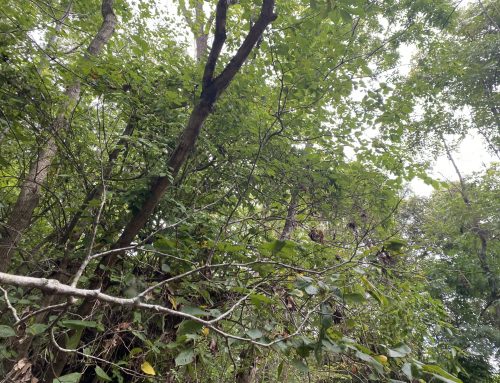
My sketch of the large bird
I entered my sit spot around 4:00PM on October 5th with the initial plan of observing this large fish I have spotted the last few times I have been near the pond. I decided instead to observe a large bird that was wading through the water instead while I sat below the tree at my sit-spot closer to the water. It was 70°F outside, though it felt cooler due to a slight breeze bringing in cold air. The large bird looked like a type of heron, but I was unsure as I sketched the animal while it moved out of sight. I decided on the bird because it was large and easy to watch from the distance, and it made it easier for me to get a sketch to be able to identify it later.
The large bird seemed to move effortlessly through the shallow water with its long, thin legs and long, flexible neck. The bird was a light gray to light blue-ish color and displayed a beautifully large wingspan when it decided to take flight. When I had arrived, the bird was originally standing on the bank, though it moved quickly to the water further from me as I walked across fallen leaves. The bird remained quite vigilant as I watched its movements and seemed very focused on what I was doing. It paid no attention to nearby fish or the aquatic turtles swimming nearby, as it seemed to see me as a possible danger. While I sketched the beautiful bird, it flew a short distance to land on a pedestal in the center of the pond, allowing me to see how large its wings were. While watching, the bird decided it was no longer safe to remain nearby and flew over to the creek behind me. I tried to walk over and watch it from being the trees, but it immediately heard me and took flight once more out of sight. Observing the movements of the bird was an interesting experience, though I wish it had not spotted me immediately, as that put the bird on edge for the entire time.

The heron perching and taking a break from wading

The heron makes its escape
Upon little research, I found that the bird was indeed a heron, and more specifically a Great Blue Heron (Ardea Herodias), as it was the only bird that matched my description of the blue feathers. The heron was simple to identify, which made it more fun for me, as I had the chance to research more about the bird rather than spending a lot of time identifying the animal. On average, these herons can be 3.2 to 4.5 feet tall, which allows them to safely wade through water without having to be submerged. The Great Blue Heron is the largest heron in North America and often spotted near inland rivers or lakeshores, though it is highly adaptable and can thrive in all kinds of waters. Herons were formerly often show due to how easy of a target they are, though this no longer occurs, so populations are stable. Herons tend to be near water due to their diet of mostly fish with the occasional frogs, salamanders, insects, turtles, rodents, and birds. Their long beak allows them to quickly strike at fish swimming nearby during the day and at night.
Herons are also known for their quiet flight, despite their wings being large and long. When hunting for prey, the heron stays very still and waits for fish to come within range before striking its beak down into a bill stab. It is also interesting to note that Herons are capable of swimming, although they are not typically spotted in deeper waters. Due to their ability to adapt almost anywhere, they have been found in freshwater wetlands, marshes, swamps, rivers, and lakes. In areas with a coast, such as Mexico and Florida, herons have been known to hunt in the surf. The heron living on campus likely hunts for fish and turtles in the nearby creek and pond, though it may also hunt down snakes and other animals within the brush.
Citations:
Great Blue Heron. (2020, April 01). Retrieved October 08, 2020, from https://www.audubon.org/field-guide/bird/great-blue-heron
Naish, D. (2016, August 31). Ode to the Great Blue Heron. Retrieved October 08, 2020, from https://blogs.scientificamerican.com/tetrapod-zoology/ode-to-the-great-blue-heron/


Your drawing is amazing!! I love blue herons so I’m really excited you decided to have it be your organism! I really enjoyed learning more about them from what you put down.
I like how after you researched what the heron ate, you related it back to some possible food sources on campus. Too bad the heron was frightened away, you could have gotten very pretty pictures, especially with that scenery. I have seen that heron a few times from the distance, and now look forward to hopefully see more of its action when walking on the loop.
I was so excited to see that someone used the heron for the species summary! I see it so often along the creek. Your research was really well thought out to connect your findings to how the heron survives on campus.
I really love your bird drawing! I think its cool that you did research on the herring, I loved the new fun facts that you provided